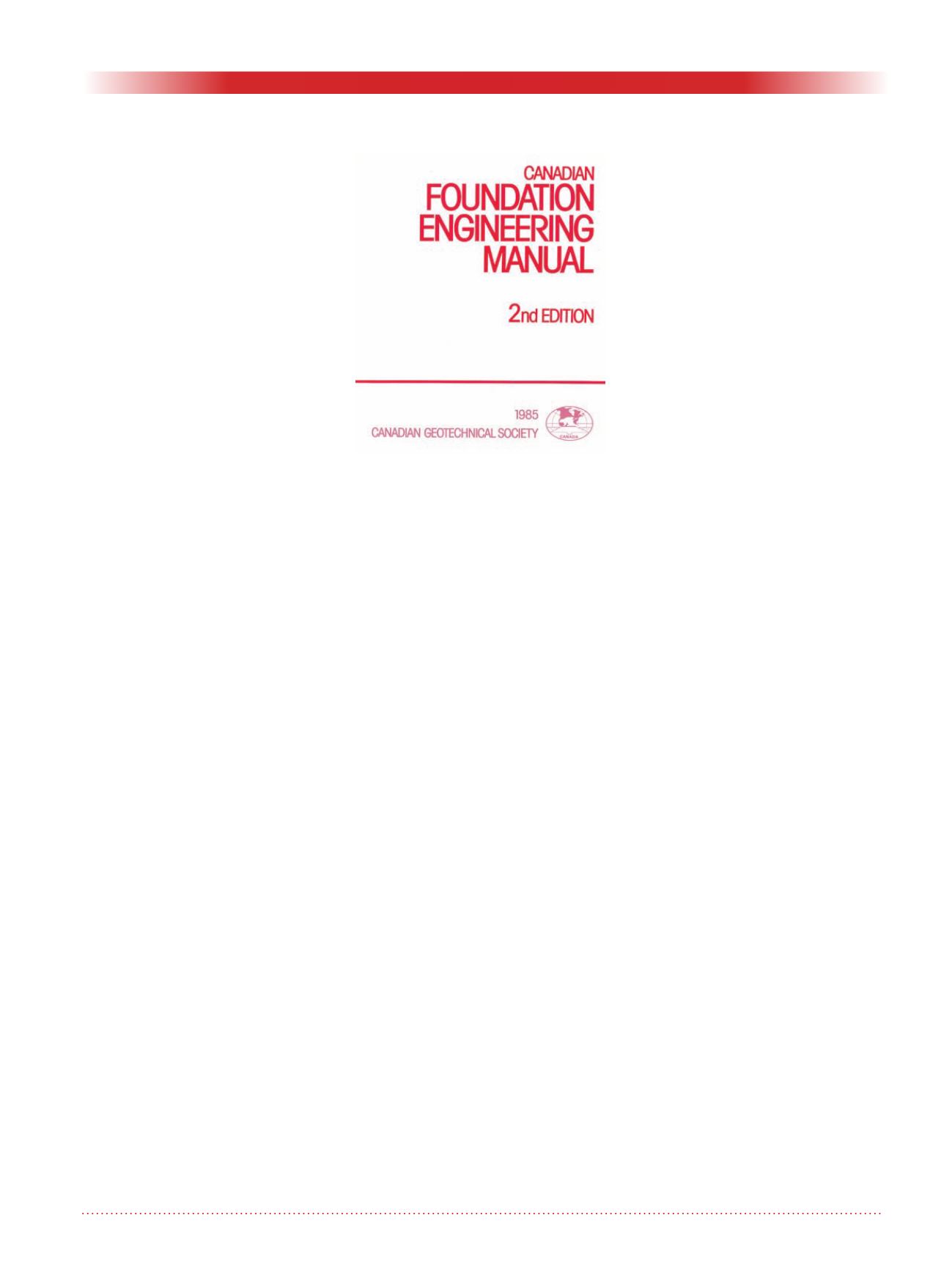
Geotechnical News • June 2018
23
COMPUTING IN GEOTECHNICAL ENGINEERING
From the GS Board
Part 4: Excavations and Retaining
Structures (68 pages)
Introduction; Theoretical Pres-
sures on Retaining Structures;
Excavation Support; Control of
Groundwater; Foundation Walls
and Retaining Walls.
Among the many differences between
the
1975 Draft Edition
and the
1978
First Edition
, the section on “Earth-
quake Resistant Design” was upgraded
from a relatively short “commentary”
to a 14-page chapter.
In addition to the statements on limita-
tions and use of experience and judge-
ment, similar to those in the
1975
Draft Edition
, the
1978 First Edition
added:
“While every reasonable effort has
been made to insure the validity and
accuracy of the information contained
in this Manual, the Canadian Geotech-
nical Society and its members dis-
claim any legal responsibility for such
validity or accuracy; persons using
this Manual do so at their own risk.”
The 1978 First Edition
also stated,
“It is the intention of the Society to
update the manual from time to time
as the need arises”.
A French version of this document
was not published. It is not known
how many copies of this edition were
printed, or the price.
1985 Second Edition of the
CFEM
In the early 1980s, under CGS
Presidents John Adams (1981-1982)
and Tony Stermac (1983-1984), the
Society presented a series of seminars
across Canada on the CFEM and its
use. Both in the
1978 First Edition
and during the seminars, comments on
and suggestions for revisions and addi-
tions to the
1978 First Edition
were
solicited. True to the Society’s stated
intention, in 1983, the CGS requested
its Foundations Committee (by then
called the Technical Committee on
Foundations) to review the comments
and suggestions and prepare a revised
manual.
This task was carried out under the
leadership of the following geotechni-
cal engineers (their organizations at
that time were not identified, but have
been added):
G.G. (Geoffrey) Meyerhof (Editor),
Technical University of Nova
Scotia (now a part of Dalhousie
University)
B.H. (Bengt) Fellenius (co-Editor),
University of Ottawa and Chair of
the CGS Technical Committee on
Foundations
F. (François) Tavenas, Université
Laval and CGS Vice President
Technical (and a member of the
early 1970s NRC Subcommittee
on Foundations), and
M. (Michael) Bozozuk, NRC DBR
and CGS Vice-President Admin-
istrative and Chair of the CGS
Committee on Publications.
David Devenny was CGS President
(1985-1986) when the
1985 Second
Edition
(CGS, 1985; Figure 2) was
published.
As stated in the preface of the
1985
Second Edition
:
“The Manual is truly produced by the
membership of the Canadian Geotech-
nical Society. The number of indi-
viduals who have contributed to the
Manual – first, the preparation of the
1975 draft, then, the 1978 first edition,
and, now, the 1985 second edition – is
very large. Through the years, there
have been about 30 members of the
Foundations Committee. In addition,
about 100 individual members of the
Society have submitted serious com-
ments and suggestions, which have
been considered in the revision work.
It is impossible to give just credit to
all these individuals. The Manual is a
manifest of the dedication of the mem-
bership at large and owes its existence
to the membership.”
The
1985 Second Edition
, similar to
the
1975 Draft Edition
, was again a
single, bound volume. The 456-page
document was printed and distributed
for the first time with the assistance
of BiTech Publishers Ltd. of Vancou-
ver, BC. (Coincidently, John Gadsby,
co-owner of BiTech Publishers, was a
member of the early-1970s NRC Sub-
committee on Foundations that wrote
the
1975 Draft Edition
.)
Although a single bound volume, the
1985 Second Edition
was still orga-
nized in the same 4 parts as the
1978
First Edition.
The name of Part 1 was
changed from “Soil and Rock Prop-
erties” to “Fundamentals” to better
reflect its content.
There were many changes and addi-
tions from the content of
1978 First
Edition
to the
1985 Second Edition
.
Among them, geotextiles were first
referenced; the section on earthquake-
resistant design was further enlarged;
limit states design was introduced; and
the references were compiled at the
end of the document. In addition, the
Imperial units that were used in the
1978 First Edition
were converted to
metric units.
The
1985 Second Edition
was the
first edition to be typed using a
word processor, as opposed to the
typewriter-typed previous editions.
Bengt Fellenius recalls that not only
was he co-Editor of this edition, but he
personally typed the entire manuscript,
and the numerous revisions, on his
“trusty” Apple computer using Word-
Star. He then sent the final WordStar
Figure 2. Cover of the 1985 Second
Edition.


